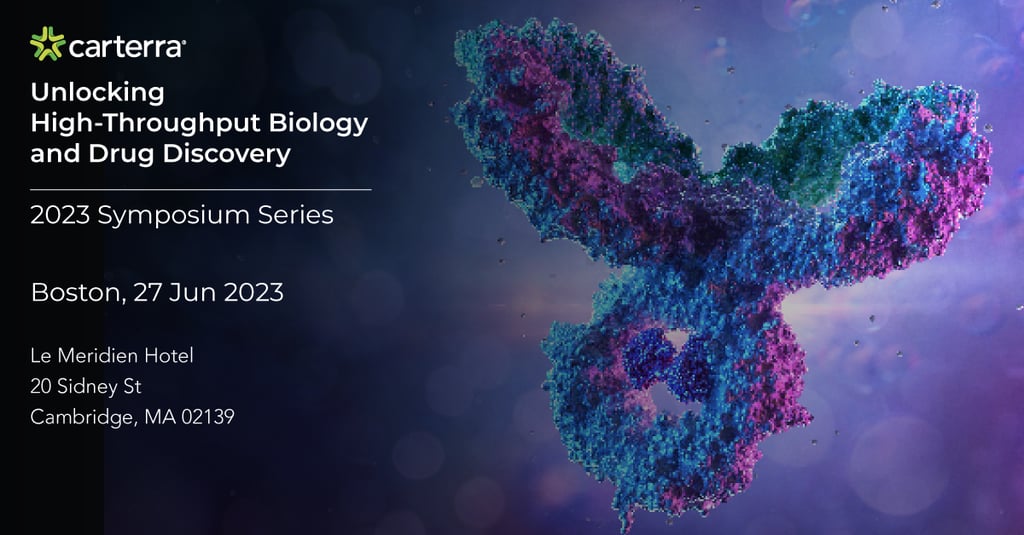
What You Will Learn
Please join Carterra at our upcoming symposium in Boston, MA. You will spend the day learning about high-throughput drug discovery and antibody therapeutics with some of the industry’s leading scientists. Our speakers will present new ways of looking at discovery, applications, and workflows, including HT-SPR. The topics you'll hear about include:
-
New methods in antibody discovery, DELs and PROTACs
-
Innovations using HT-SPR for drug discovery
-
Challenging assay formats, such as membrane targets and rapid binders
-
Strategies to streamline characterization workflows
-
Best practices in experimental design and analysis
Network with your peers. Lunch will be provided. Registration is required as seating is limited.
Register Here
Agenda |
|
|
8:45am – 9:00am |
Arrive and Check-in |
|
9:00am – 9:30am |
Networking and Coffee/Tea |
|
9:30am – 9:45am |
Symposium Begins—Welcome |
|
9:45am – 10:30am |
|
| Abstract: This talk will cover our efforts to combine computational modeling, HTP protein-protein interaction assays, and biophysical characterization to engineering improved biologics. | |
|
10:30am – 11:00pm |
|
|
|
Abstract: Selection of bi- and tri-specific binders often require the screening of large combinatorial sample sets derived from panels of single domain binders. The Carterra LSA platform makes analyzing the binding properties of these molecules straightforward and requires minimal amounts of mAb sample and antigen. The affinity of the binders to the targets can be measured in several assay formats and used to verify the independence and activity of each binding site for hundreds of clones. Along with the binding kinetics and specificity measurements, the LSA enables large scale epitope binning to ensure diverse sets of clones are being carried forward to functional evaluation. |
|
11:00am – 11:30am |
Break and Networking |
|
11:30pm – 12:00pm |

Bradley Lunde, PhD, Group Leader, Adimab |
| Abstract: We describe the design and deployment of a novel, synthetic heavy chain-only antibody platform that allows for efficient isolation and characterization via an integrated yeast presentation and production platform. We will discuss the productivity of this library across multiple therapeutically relevant targets and highlight how Carterra LSA multi-concentration kinetics and comprehensive binning unlock fundamental insights of this platform. | |
|
12:00pm – 1:00pm |
Lunch and Networking |
|
1:00pm – 1:30pm |
|
| Abstract: The LSAXT expands the capabilities of HT-SPR to meet the demands of challenging assay formats. By building on the established benefits of HT-SPR including more data in less time with less sample, LSAXT has the versatility to address a range of experimental workflows. This talk will highlight how LSAXT is a robust platform for characterization of drug candidates including PROTAC®s and kinase inhibitors. The benefits of enhanced sensitivity and overall data quality in LSAXT take HT-SPR to a whole new level. | |
| 1:30pm – 2:00pm |
|
| Abstract: Fc gamma receptor (FcγR) binding is a critical component of ADCC, ADCP, and CDC and an important feature to measure in Fc-containing drugs. The purpose of our study was to determine if testing IgG drugs against a full panel of biotinylated FcγRs can be completed on Carterra’s LSAXTinstrument with higher throughput than a traditional 8-channel biosensor while maintaining equivalent data quality. Our results show that the LSAXT demonstrates highly comparable data relative to the traditional 8-channel biosensor while using 7.5 times less analyte, 6 fewer hours of analyst time, ~$3,000 less in consumables, and producing 8 times as many replicates. | |
| 2:00pm – 2:30pm |
Break and Networking |
|
2:30pm – 3:00pm |

Lucy Liu, PhD, Senior Director, Head of Global Bioanalytics, Alloy Therapeutics |
| Abstract: In addition to having the desired interaction and mode of action on the target, therapeutic antibodies need to be highly specific. Non-polyspecificity is one of the most important characteristics to have for safety, efficacy, and ideal PK/PD. Since polyspecificity is difficult to get rid of by engineering, assessing it early in the antibody discovery process is crucial. In this study, we developed a new high-throughput HT-SPR-based assay for polyspecificity screening. To validate the assay, we compared it to traditional assays such as ELISA or flow cytometry by using clinical stage antibodies. Where possible, results were correlated to clinical outcomes in literature. This assay is high-throughput and consumes very small amounts of sample, enabling polyspecificity de-risking at an early stage in the discovery process. | |
| 3:00pm – 3:30pm |
|
| Abstract: Artificial intelligence (AI) has the potential to greatly increase the speed, quality and controllability of drug creation. We showcase such potential on two antibody drug creation tasks: de novo design and lead optimization. For the first task, we utilize generative AI models for zero shot design of antibody CDRs. In particular, we screen over 1 million antibody variants designed for binding to human epidermal growth factor receptor 2 (HER2) using our high-throughput wet lab capabilities. Our models successfully design all CDRs in the heavy chain of the antibody and compute likelihoods that are calibrated with binding. We achieve binding rates that are several multiples higher than HCDR3s and HCDR123s randomly sampled from the Observed Antibody Space (OAS). We further characterize 421 AI-designed binders using surface plasmon resonance (SPR), finding three that bind tighter than the therapeutic antibody trastuzumab. The binders are highly diverse, have low sequence identity to known antibodies, and adopt variable structural conformations. For the second task, we show that our high-throughput screening assay can generate quantitative binding affinity scores for hundreds of thousands of antibody variants. After validating these scores with SPR, we use this data to train large language models that accurately predict binding affinities for unseen antibody variants. These models can be used to co-optimize multiple antibody properties, as we demonstrate by designing variants of trastuzumab with up to seven mutations and with over ten-fold increase in binding affinity. Combined, these approaches promise to accelerate and improve antibody drug creation, and may increase the success rates in developing novel antibody and related drug candidates. | |
|
3:30pm |
Symposium Ends |
 Grant Murphy, PhD,
Grant Murphy, PhD,  Maria McGresham, PhD, Field Applications Scientist, Carterra
Maria McGresham, PhD, Field Applications Scientist, Carterra Noah T. Ditto, Technical Product Manager, Carterra
Noah T. Ditto, Technical Product Manager, Carterra Zachary V. Fagiani, Associate Scientist, Dragonfly Therapeutics
Zachary V. Fagiani, Associate Scientist, Dragonfly Therapeutics Amir Shanehsazzadeh, Senior AI Scientist, Absci
Amir Shanehsazzadeh, Senior AI Scientist, Absci